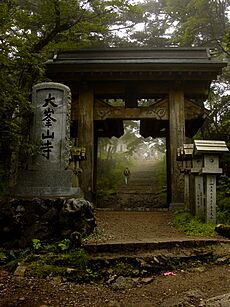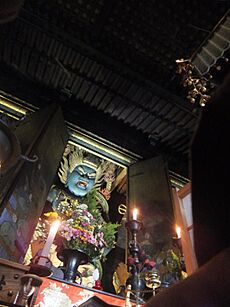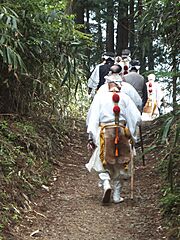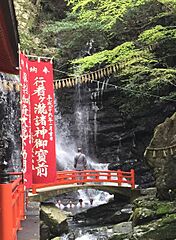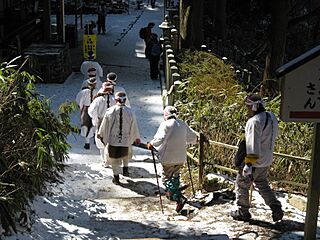Shugendō facts for kids
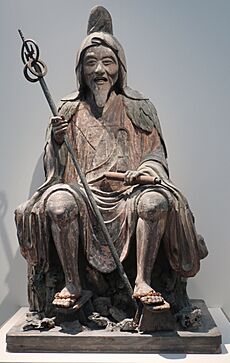
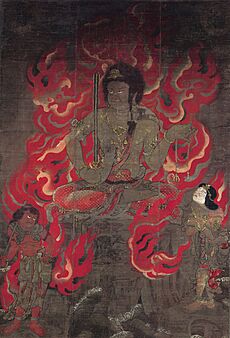
Shugendō (pronounced Shoo-gen-doh) is a special Japanese religion that combines different beliefs. It mixes ideas from local Japanese traditions, Shinto mountain worship, and Buddhism. This religion started around the 7th century in Japan.
The main goal of Shugendō is for people to gain spiritual power. They do this by training hard in steep mountains. This training helps them become stronger inside and help others. People who practice Shugendō are called Shugenja or Yamabushi. The word Yamabushi means "Mountain Prostrator," showing how much they respect the mountains.
Shugendō is practiced in mountains all over Japan. Some famous mountain ranges include the Ōmine mountains, which have Mount Hakkyō and Mount Ōmine. The Ishizuchisan mountains, with peaks like Kamegamori and Tengudake, are also important.
The Shugendō religion has many gods and spirits. These include figures from both Buddhist and Shinto beliefs. Two very important Buddhist figures are Fudō Myōō and Dainichi Nyorai. Another key type of figure is called a Gongen. These are seen as Buddhas who appear in Japan as local gods, or kami. Zaō Gongen is one of the most important Gongen in Shugendō.
Contents
History of Shugendō
Shugendō grew over time, starting in the 7th century. It brought together local folk beliefs, Shinto mountain worship, and Buddhist ideas. A monk named En no Gyōja is often seen as the founder of Shugendō. He helped organize its teachings.
The name Shugendō means "the path of training and testing." It also means "the way to spiritual power through discipline." Some people believe that Shugendō practitioners are connected to the Kōya Hijiri monks from the 8th and 9th centuries.
How Shugendō Developed
From the 9th century, Shugendō started to include ideas from a type of Buddhism called Vajrayana. This included Shingon and Tendai Buddhism. During the Heian period (794-1185), it became very popular. Many nobles from Kyoto would visit Kumano Sanzan. These three major shrines were a holy place for Shugendō, Shinto, and Buddhism.
Shugendō in Modern Times
In 1872, the Meiji government made a rule to separate Shinto and Buddhism. Because Shugendō mixed these two religions, it was officially banned. However, after World War II, people in Japan gained religious freedom. This allowed Shugendō to be practiced again.
In 1907, a team of climbers reached the top of Mount Tsurugi. This mountain was thought to be the last unclimbed peak in Japan. But they found an old metal cane decoration and a sword there. This showed that someone had climbed it before them. Later, scientists found that these items were over 1,000 years old. This proved that shugenja had climbed Mount Tsurugi long ago.
The Ōmine mountain range is a very important place for Shugendō training. It stretches for 100 kilometers between Yoshino and Kumano. The highest peak is Mount Hakkyō, which is 1915 meters tall. There are 75 special spots along the mountain trails for training. Ōminesan-ji Temple, at the top of Mount Ōmine, is considered the most sacred Shugendō site. Today, the Ōmine mountain range is a UNESCO World Heritage Site. It is part of the "Sacred Sites and Pilgrimage Routes in the Kii Mountain Range" and Yoshino-Kumano National Park.
Today, Shugendō is mainly practiced through Tendai and Shingon temples. Some important temples include Kimpusen-ji in Yoshino and Daigo-ji in Kyoto.
Shugendō Practices
Shugendō involves many different rituals and practices. These include special ceremonies, telling the future, prayers, and ways to remove bad spirits. The people who practice Shugendō believe in two main worlds. One is the world we live in every day. The other is a spiritual world that controls our daily lives.
Mountains are seen as sacred places that connect these two worlds. They are also believed to be part of the spiritual world itself. Special altars used during fire ceremonies are also considered sacred spaces.
Key Deities and Mountain Training
The Buddhist deity Fudō Myōō is very important in Shugendō. He is seen as "Immovable" and plays a central role. Another important Buddha is Dainichi Nyorai. The Shugendō religion also includes many other Buddhist, Shinto, and local gods.
The most important Shugendō practices are called "practices in the mountains" (nyūbu shugyō). In Shugendō, sacred mountains are seen as the home of many gods. They also represent the entire universe. Shugenja believe they gain spiritual power from Fudō Myōō. They get this power by doing their mountain training.
There are three main types of mountain practices:
- Making Offerings: Entering the mountain to offer flowers or read special texts to honor Buddhas and other gods. This is based on the idea that the mountain is a sacred place, like a special map of the universe.
- Mountain Retreats: Staying in the mountains for a certain time. During this retreat, yamabushi do various tough exercises. They also learn secret knowledge and special ceremonies.
- Winter Retreats: The hardest and most advanced practice is training in the mountains during winter. This is believed to give very special spiritual powers.
Shugendō also has unique initiation ceremonies called shōkanjō. These are based on Buddhist ceremonies but are special to Shugendō.
Other Important Practices
Another important part of Shugendō is showing magical and spiritual powers. These displays might include walking on fire, walking on swords, or stepping into boiling water.
Shugendō practitioners also perform worship rituals called kuyōhō. This involves making offerings to Shugendō gods like Fudō Myōō and Zaō Gongen. They also chant special prayers.
Shugenja also take part in Shinto festivals (matsuri). They make offerings to the kami (Shinto gods).
Other practices in Shugendō include:
- Fortune-telling** and **divination: Trying to predict the future.
- Oracles: Getting messages from gods through people who can communicate with spirits.
- Fire ceremonies: Special rituals with fire to prevent bad luck. These often focus on Fudō Myōō.
- Incantations: Using special words or chants for a specific purpose.
- Spells and charms: Used for healing, helping with childbirth, or for protection. These can be written on amulets.
- Exorcism: Removing bad spirits for healing.
Shugendō ritual leaders also perform prayers and ceremonies for specific gods. These include Buddhas like Yakushi and Amida. They also pray to Bodhisattvas like Monju and Kannon. Some Indian gods like Benzai-ten and Japanese Kami like Inari are also part of their worship.
Notable Shugendō Sites
Many places are famous for Shugendō and are popular for pilgrimages.
- Mount Ōmine (Ōminesan): The main temple here is Ominesan-ji Temple.
- Mount Kinpusen (Kinpusen): This mountain is linked to the deity Zaō Gongen. Its main temple is Kinpusen-ji Temple.
- Ishizuchisan: This mountain is connected to the deities Ishizuchi Kongo Zaō Dai Gongen and Hōkibō Daitengu. Its main temple is Gokurakuji.
- Mount Haku: This mountain has several peaks over 2,000 meters, including Gozenpō and Ōnanjimine.
- Sanyama-sama: These are the three mountains of Dewa Sanzan.
- Mount Haguro (Hagurosan): Linked to Shō-Kannon Bodhisattva and Ukanomitama-no-Mikoto. The Haguro Autumn Peak Ritual is held here.
- Mount Gassan (Gassan): Linked to Amida Buddha and Tsukiyomi-no-Mikoto.
- Mount Yudono (Yudonosan): Linked to Dainichi Buddha and Ōyamatsumi no Kami.
- Mount Minō (Minōsan): Located near Osaka in the Ikoma Mountains.
- Mount Izusan (Izusan): In Shizuoka Prefecture. Its main temple is Izusan Shrine.
- Mount Katsuragi (Katsuragi): Located between Nara and Osaka Prefectures.
- Takisanji Temple: A Tendai Sect temple in Okazaki City, Aichi Prefecture.
- Mount Ontake (Kiso Ontake): Overlooks the Kiso Valley in Aichi Prefecture.
- Mount Mitoku (Mitokusan): Home to Sanbutsu-ji Temple in Tottori Prefecture.
Gallery
See also
- Kaihōgyō
- Mikkyō
- Milarepa
- Mount Hatsuka
- Mount Hiei
- Mount Ōfuna
- Mount Ōmine
- Onmyōdō
- Sokushinbutsu



